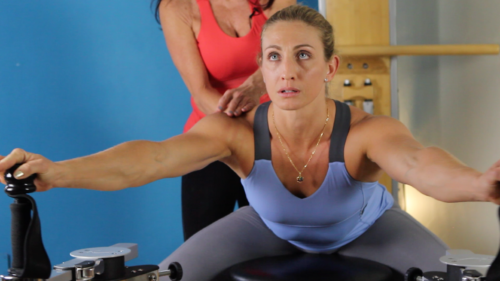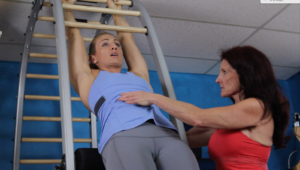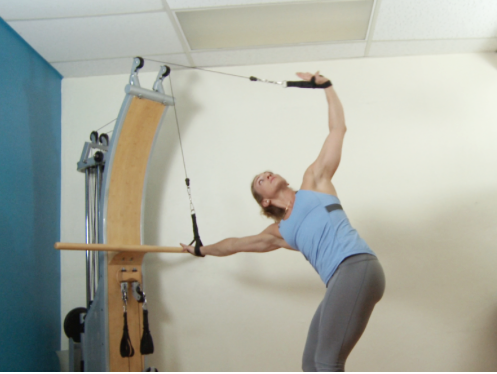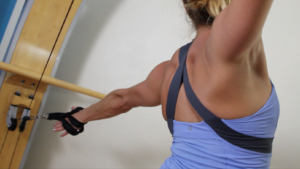How the GYROTONIC® Method Can Improve Training For High Level Athletes
Blog Content Interviews // May 18, 2017
GYROTONIC Communications Director and Educational Assistant to Juliu Horvath, Sarah Simpson and I sat down for an interview with GYROTONIC® and GYROKINESIS Master Trainer, Angela Crowley, to talk about working with elite athletes and using these methods to help them enhance training and performance.
Sarah: Thank you for taking the time to visit with us, Angela. First, let’s start with how you got started on this journey?
Angela: My mom had a dance and gymnastics school, so I grew up around movement. I was assistant teaching by the time I was 9 years old. I became a competitive, elite gymnast and later transitioned to a professional career in dance. Then, I got into a car accident that changed my life. Traditional medical approaches such as traction in the hospital and intensive physical therapy had only helped a little. I was told to learn to write with my other hand. If I sat for an hour my right leg would fall asleep. I didn’t accept this outcome. So, I started searching.
Nothing really helped me until I met a naturopathic doctor who directed me onto a holistic path consisting of Pilates, deep neuromuscular therapy, osteopathy, acupuncture and anti-inflammatory dietary changes. I also began studying Feldenkrais, a somatic approach addressing the organization of movement through the whole body via the nervous system. Based on normal developmental movement, these patterns translate to sports readily. With that understanding, I found myself frustrated in the Pilates system, in terms of accessing normal, full body flowing movement patterns.
As a former gymnast and dancer who had been injured, I naturally attract those populations, in my teaching. I’ve also had the pleasure of working with a wide variety of athletes from recreational to world-class and Olympic athletes. These have included race car drivers, runners, divers, triathletes, and an Olympic pole vaulter.
Sarah: What was different about the Gyrotonic Method and made it different for you?
Angela: Ah, the golden moment. I saw a picture of someone on a Gyrotonic machine with her hands on the handles. I could see that the movement of the handles gave access to, and facilitated, the movement of the spine. My search was answered. Many people including myself have neck and low-back problems. In order to solve those issues, you have to deal with the movement between the two – the mid-back and ribcage. Using the Gyrotonic Method was the first place where I felt I could successfully do that. I went to New York and studied with Juliu Horvath, who was still making each of the Gyrotonic machines by hand, at that time. I’ve now been teaching the Gyrotonic Method for more than 20 years.

Canadian, two-time National Champion diver, Melanie Rinaldi training on the Gyrotonic Pulley Tower handle units with Gyrotonic Master Trainer, Angela Crowley.
Sarah: One of the things I’ve heard you talk about before is the “wave of motion.” Tell us about that?
Angela: That’s the magic. If you imagine any sport, let’s use running, for example, there is a wave of motion that happens from the foot, through the leg, through the pelvis, through the spine, into the air and then, it reverses down into the landing. If you think about basketball, there is a wave of movement that goes from the floor, through the body, out through the fingertips.
One of the most fundamental, quintessential movements of the Gyrotonic Method is called the “wave,” which is a flowing movement of the spine. It is the single most unique and valuable theme in this method that separates it from every other exercise system, not only in terms of sports performance, but also because of the extensive health benefits. The fluidity is similar to tai chi or swimming.
In the wave motion, the amount of articulation of the spine is highly unusual. If you think about how many people have back pain, it’s illogical that most exercise systems focus mostly on the arms and the legs. It’s equally ridiculous, in terms of sports, because spinal movements are part of not only every motion in daily life, but also in terms of every sport. Again, if you think about the way a basketball player is going down and then coming up, or the way a diver is folding and unfolding the body, it’s the center of the body that is leading that motion to make it happen. Or, think about the sideways motion of the spine in a skater, or the spiraling movement of the spine in a golfer, even in walking there is a counter spiraling action that happens in our spine, which is even greater when we’re running. Yet, most training systems don’t give us access to train in ways that include those spinal dynamics.

Many workout systems work one muscle group and then another in parts. However, sports movements don’t occur in parts. Thinking only in terms of training strength and flexibility is a gross oversimplification of the requirements of an athlete. Performance is based on an artful orchestration of strength and flexibility that wave through the body. There are pathways of movement that are dependent on rhythm, timing, and coordination in their execution to get to the end result. So why not train that way ?
Let’s go back to running or tennis and think about recreational athletes. In our culture, we spend so much time sitting that our spines, hips, and legs become prejudice to folded positions. We forget how to unfold them. So, people get up from their desk and go to run, but their hips and their low back are still in the form of sitting at their desk. So, they are running with their hips in the position of sitting instead of pushing the ground behind them and extending through the hips. This breaks the wave of motion and puts substantially more impact on all the joints, especially the low back and knees. Without unfolding the spine and hips from the sitting position, we easily end up in a walker with the spine curved like sitting at a computer.
For that wave of motion to be fluid, it needs to be distributed throughout the whole body. The more joints that help in any movement, the less stress there is. If you think about all of the joints, starting with the foot, the foot should have a buoyancy to be a springboard and a shock absorber. It shouldn’t be rigid, at all. Then, you’ve got the ankle, the knee, the hip, and then the spine with five levels in the low back, twelve in the mid-back, and seven in the neck. Then, you’ve got the shoulder girdle, the elbow to the hand, etc…
So, if you’re throwing, every single one of those, from the foot to the hand, should be involved. However, people habitually move from only a few joints. Therefore, those few joints are under incredible stress, and wear and tear. By distributing forces equally through each of the joints, each one has less stress and each one has greater finesse. The overall organism has more power. Whether you are pushing off to jump, or landing from something like a ski jump where the impact is substantial, you have more buoyancy. The body becomes more like a spring and is supple. Efficiency and energy expenditure are also improved while proactively reducing injuries.
Sarah: So, what comes to mind in hearing you talk about this is tensegrity and fascia. Are you looking from those perspectives?
Angela: I’m looking from a number of perspectives, including principles of physics such as load and distribution of forces as we were just discussing. Here is an analogy for you: If one person picks up a big piece of equipment, it’s really heavy. If two people pick it up, it’s a little lighter, if 5 people help, it’s a lot lighter, etc… That’s how the forces need to be distributed throughout your body if you are trying to throw a ball, or trying to propel your own body into the air. The more parts that are helping, the easier it is.
Tensegrity is based on a balance of tensions that create space, and tensile strength that is extraordinarily resilient, like suspension bridges. A balance of tensile forces in the body ideally translates to equal strength, and equal flexibility, on all sides of all joints, and in every different plane of motion and relationship with gravity. This balance of tensile strength protects our joints. What I mean by that is, if you are looking at the knee joint, for example, people tend to be overdeveloped in their quads, really tight in the IT band and TFL on the outside of the knee, and much weaker on the inner thigh and hamstrings, comparatively. That puts the knee joint in a very vulnerable position in terms of the space in the joint, power of the joint, and the stress in the joint absorbing shock.
By moving in a vast variety of planes, relationships with gravity and assistive or resistive forces, Gyrotonic exercises help create tensegrity in the body. This is one of the things that makes this system so unique. We’re not going back and forth in the same plane of motion. This diversity in training then prepares the body to be ready to move in any different plane. Sports don’t happen on a straight, perfect track. Movement happens all over the place. We want to train the body to be prepared to deal with movement from anywhere. When you’re running, if there’s a hole in the road, or someone comes at you from an unexpected angle, we want to educate the body to be prepared for that..
The fascia, the networking web of all of are tissues, is reflective of how we use our bodies. Going back to the person sitting in the chair most of the time and then running, some of the fascia has become short and some has become slack making an activity like running difficult. Gyrotonic movements help rebalance the tensile forces and freedom of our fascial webbing, thus supporting space in our bodies and creating ease in our movements.

Sarah: Can you talk about the unique circularity of movement we use in the Gyrotonic Method?
Angela: Well, there is not a single right angle shape in the entire body. Even in the joints and the shape of the bones are rounded or spiraling. So, why in the world are we training in angular movements? All movement in nature is circular. Look at the power of a hurricane and how powerful that circular force is compared to a linear hinge, which has a breaking point. Think about the invention of the wheel and how it distributes forces. Expand that capacity into a sphere, and you will have multiplied the distribution of forces, dramatically. Again, this is how we reduce the stress on the body and create fluidity in movement.
A beautiful circular image is throwing a ball. The body waves into an arc in the one way, and then rhythmically reverses it. There are circles everywhere in movement.
Sarah: What about rhythm in movement. How does that play a role?
Angela: Rhythm makes or breaks the success of a movement.. Without rhythm the wave of motion is broken, which then breaks down efficiency. Without rhythm, strength and flexibility are meaningless. It’s the rhythm that ultimately creates the outcome and allows finesse in movement.
In the Gyrotonic Method, rhythm is organic to all exercises. For example, in arch and curl, the movement I described with the hands on the handle units, there is a rhythm that is happening with the ground force of the floor, igniting the power from the pelvis, through the spine and traveling out through the arms. Rhythm is fundamental to every Gyrotonic movement, just as the movement of a wave is fundamental to every motion. So, in Gyrotonic we are concurrently training rhythm, training coordination, training strength and flexibility, all at once.
Sarah: Why does that matter for an athlete?
Angela: Well, no sport is broken down into pieces. It happens in a sequence of events from the floor and through to the hand when throwing the ball, or using the tennis racket. Rhythm, strength, and flexibility are not separate things, they are inter-dependent.
The ability of an athlete to move rhythmically is extremely vulnerable to stress of any sort, and performance anxiety. In the Gyrotonic Method, we also work with the inner athlete, the nervous system, the conductor behind the scenes. Gyrotonic exercises effectively tune the inner athlete to be calm, sharp, focused, and adaptable.
This becomes really important, for example, with an injured athlete who is accustomed to training five hours a day in their sport, but has to take a break due to a surgery. There is all of this bound up energy inside, and you have to do something with that to be effective.
The Gyrotonic approach challenges the nervous systems through variations in tempos, resistances and sequences. When an athlete trains the same way, over and over again, the nervous system is less adaptable. So, we change the dynamics of training to wake up the nervous system, so it is constantly recalibrating and learning to actively do that. Training someone to stress their body physically, while keeping their breath and mind clam, is essential to sports.
Sarah: Talk more about strength and flexibility.
Angela: They are really two sides of the same coin. For example, when we first came to Miami, we did some work with the University Of Miami baseball team. We were brought in to help reduce shoulder injuries. When you think of the range from which they have to throw, you’d think those guys would be extremely flexible, but they could not put their arms over their heads and lace their hands together because they were so tight. When throwing a ball, the greater the flexibility to reach backwards, the greater the power to throw forwards.
In the approach to strengthening, the Gyrotonic equipment is also quite unique. For example, the Gyrotonic Leg Extension Unit, which is patented and completely different than any leg extension units in a gym, allows the power to initiate through the center of the body and then out through the leg. The equipment is designed so that as the leg extends, the space increases, and the knee joint is decompressed. Regular gym leg units are contraindicated for many knee problems because they put too much stress back into the joint.
Many strengthening systems load weight at the extremities of the body at the expense of the spine. Gyrotonic does the reverse, creating power from the body’s center out through the leg or arm. As martial artists have always known, power is centered in the pelvis.

Flexibility is often misunderstood. An overly stretched muscle is equally risky. In Gyrotonic movements, we are working flexibility actively, or within ranges that the muscle is engaged. The Gyrotonic equipment and techniques allow a unique level of active control. This creates long, lean functional muscles that protect our joints versus overly stretched muscles that make our joints more vulnerable.
The balance of strength and flexibility is critical to maximizing efficiency and preventing injury. Overly strong and overly flexible muscles are equally dysfunctional. We want to create efficient power and resilient flexibility
Sarah: So, you’re really talking about the core of the body, right?
Angela: Yes, right, but what is “core” strength? It’s such a buzz word, but it’s really misunderstood and misused. There is this idea that it means you have to have really, really strong abs. But crunches don’t make intelligent abdominal muscles. I mean, what is core strength when you are serving a tennis ball? It has to relate to the timing and the path of the body so that the core comes into play at just the right moment to have the power to hit the ball. Or, if you’re landing from a ski jump, there’s no amount of crunches that are going to prepare the abdominals to have a resiliency to land at a funny angle. The Gyrotonic movements do train for that. They create suppleness, resiliency, and strength, all at all different angles, so the core is then dynamic and ready to deal with any unforeseen circumstance.
Sarah: What would you say to an elite athlete who asked you what this system is?
Angela: I would tell them that this is the only system I’ve ever seen that can work sports specifically, while improving performance, reducing injury and accelerate training all at the same time.
Sarah: Thank you so much for your time and insights, Angela!
——————-
You can learn more about Angela’s work, and her course, “Gyrotonic Applications for High Level Athletes,” at: www.gyrotoniccoralgables.com and www.angelacrowley.net.
——————-

Cina Canada is a GYROTONIC® Trainer and the Media Coordinator for GYROTONIC® International Headquarters.
